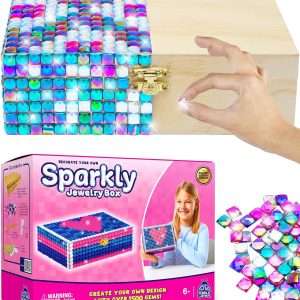Exploring the World Through Kids’ Creativity: Why Art is Essential for Growth
Imagine a world where kids express their thoughts and feelings through vibrant colors, unique shapes, and imaginative designs. Art isn’t just a fun pastime; it plays a crucial role in the growth and development of children. From enhancing cognitive skills to fostering emotional intelligence, engaging with art can profoundly shape how children see themselves and interact with others.
Kids’ mosaic kits are an excellent way for young creators to dive into this colorful universe. These kits spark creativity while offering endless possibilities for exploration. As we delve into the multifaceted benefits of art, you’ll discover how these experiences nurture well-rounded individuals ready to take on the world’s canvas. Explore why incorporating artistic activities is essential for every child’s journey!
How Art Enhances Cognitive Development
Art stimulates the brain in remarkable ways. Kids engaging with various art forms enhance critical thinking and problem-solving skills. Every brushstroke or mosaic piece challenges them to decide color, texture, and form.
Creating art also develops fine motor skills. Gripping a paintbrush or carefully placing mosaic tiles improves hand-eye coordination and dexterity. These physical tasks lay the groundwork for more complex activities later on.
Moreover, art encourages innovation by inviting children to think outside the box. They learn that there are no wrong answers to creativity—only opportunities for exploration.
Engaging in artistic pursuits can even enhance memory retention. Kids often recall concepts better after expressing them visually. This connection between visual representation and cognitive understanding also influences their overall academic journey.
The Role of Art in Emotional and Social Growth
Art serves as a powerful outlet for children to express their emotions. Through painting, drawing, or using kids’ mosaic kits, they can convey feelings that may be difficult to articulate with words. This process fosters emotional intelligence.
Socially, collaborative art projects provide opportunities for teamwork and communication. Kids learn to share ideas and negotiate roles while creating something together. These interactions enhance their social skills and build friendships.
Additionally, art encourages empathy by allowing children to view the world differently. Creating or appreciating diverse art forms helps them understand varied experiences and backgrounds.
As they engage in artistic activities, children develop resilience too. They learn that mistakes are part of the creative journey, which builds confidence and adaptability in challenging situations. Embracing creativity nurtures individual growth and strengthens connections with others in their community.
Encouraging Self-Expression and Confidence through Art
Art provides a vibrant platform for kids to express themselves. Whether it’s through painting, sculpting, or using kids’ mosaic kits, the creative process sparks imagination. Each stroke of color or tile placement allows children to communicate feelings they may not have words for.
As they create, kids experiment with ideas and emotions. This exploration nurtures their self-awareness and helps them develop a unique voice. The joy of seeing their work come together fosters pride.
Mistakes become opportunities for growth rather than setbacks. Through art, children learn that imperfection is part of the journey, building resilience.
Creating in a non-judgmental space encourages risk-taking, too. Kids gain confidence as they share their creations with others, learning to value their contributions—and themselves—more deeply each time.
Incorporating Art into Education: Benefits for Academic Performance
Integrating art into the educational experience can profoundly enhance students’ academic performance. When children engage in creative activities, they develop essential critical thinking skills across all subjects.
Art encourages problem-solving and innovation. Working with materials like kids’ mosaic kits fosters a hands-on approach, allowing learners to explore concepts visually. This method often leads to a deeper understanding and retention of information.
Moreover, art stimulates motivation and engagement. Students who participate in artistic projects typically show improved focus in their studies, as creativity sparks interest and enthusiasm for learning.
Collaboration is another key benefit. Group art projects teach teamwork while enhancing communication skills. These experiences encourage students to share ideas openly, cultivating an inclusive classroom environment that promotes collective success.
Cultivating Cultural Awareness and Appreciation Through Art
Art provides a window into diverse cultures, broadening children’s understanding of the world. Children learn to appreciate different perspectives and traditions when they engage with various art forms, such as painting, sculpture, or crafts, using kids’ mosaic kits.
Children develop empathy for others’ experiences and histories by exploring art from around the globe. They grasp that each piece of art tells a story—stories reflecting values, struggles, and triumphs unique to every culture.
Encouraging participation in multicultural art projects introduces students to various techniques and their significance within cultural contexts. This exposure nurtures an appreciation for diversity beyond mere recognition; it fosters respect.
Incorporating these experiences into play or educational settings can spark conversations about global citizenship and shared humanity. As children create their own masterpieces inspired by different cultures using tools like kids’ mosaic kits, they become active participants rather than passive observers in celebrating diversity.
Through this artistic journey, kids cultivate skills and a lifelong love for learning about the rich tapestry of human expression. Such engagement ensures that future generations grow up appreciating the beauty found in both similarities and differences across cultures.


